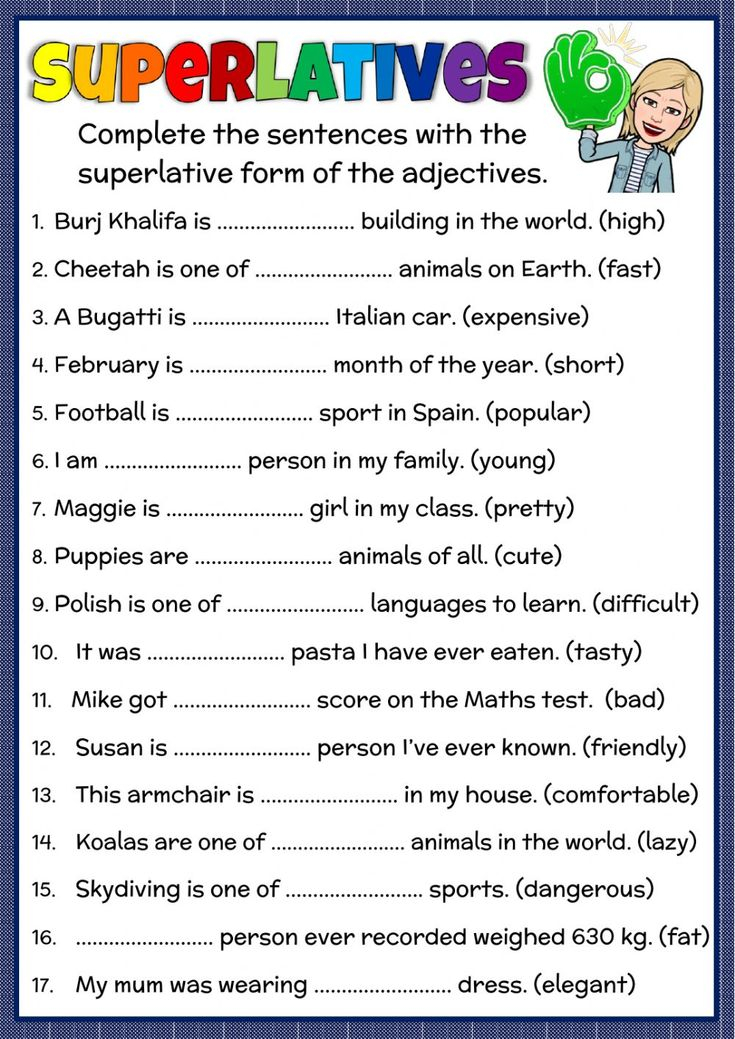
Unleashing the Power of Precision: A Deep Dive into the Superlative Adjectives Worksheet
In the vast and intricate landscape of the English language, mastering the nuances of grammar is paramount for effective communication. Among the many grammatical concepts that learners encounter, adjectives play a crucial role in adding color, detail, and specificity to our descriptions. However, merely understanding what an adjective is isn’t enough; true linguistic prowess comes from knowing how to use them with precision, especially when comparing things. This is where superlative adjectives come into play, allowing us to identify the absolute extreme within a group. And for those looking to solidify their understanding and application of these powerful words, an expertly crafted superlative adjectives worksheet stands out as an indispensable tool.
This comprehensive article will explore the importance of superlative adjectives, delve into their formation rules, highlight why a dedicated worksheet is so beneficial, examine the components of an effective one, and provide guidance on how to maximize its utility for learners of all levels.
Understanding Superlative Adjectives: The Peak of Comparison

Before we discuss the merits of a superlative adjectives worksheet, let’s first establish a clear understanding of what superlative adjectives are. Adjectives, in general, describe nouns or pronouns. They tell us "what kind," "how many," or "which one." When we want to compare two things, we use comparative adjectives (e.g., taller, faster, more beautiful). But when we want to compare three or more things and identify the one that possesses a quality to the highest or lowest degree, we use superlative adjectives.
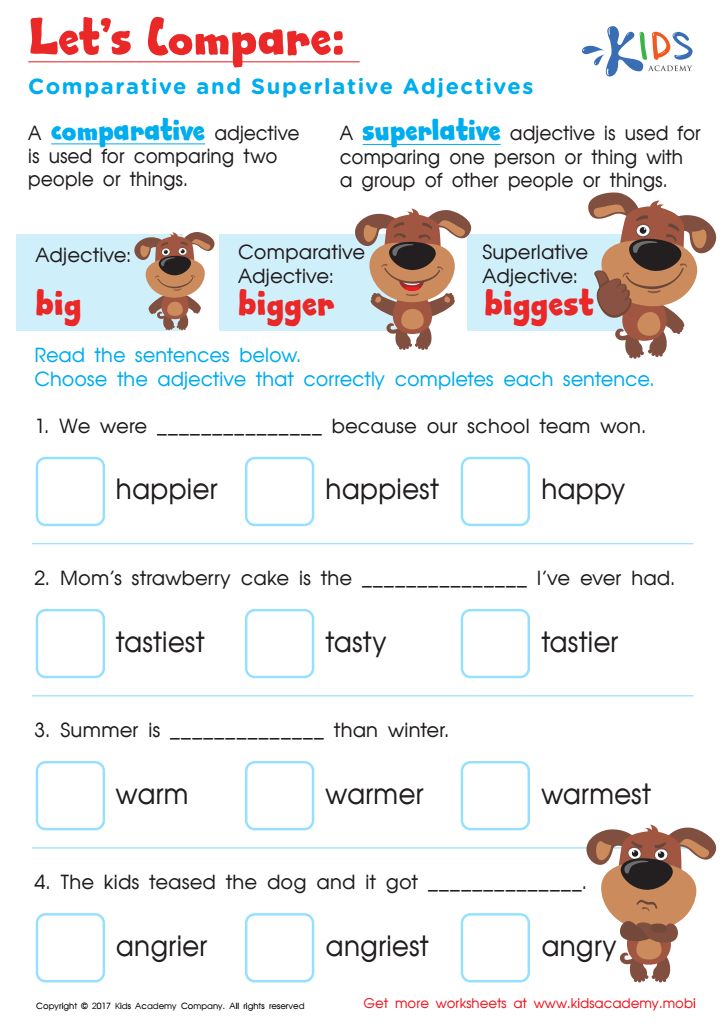
For example:

- Positive: tall (describes a single person)
- Comparative: taller (compares two people)
- Superlative: tallest (compares three or more people and identifies the one with the greatest height)
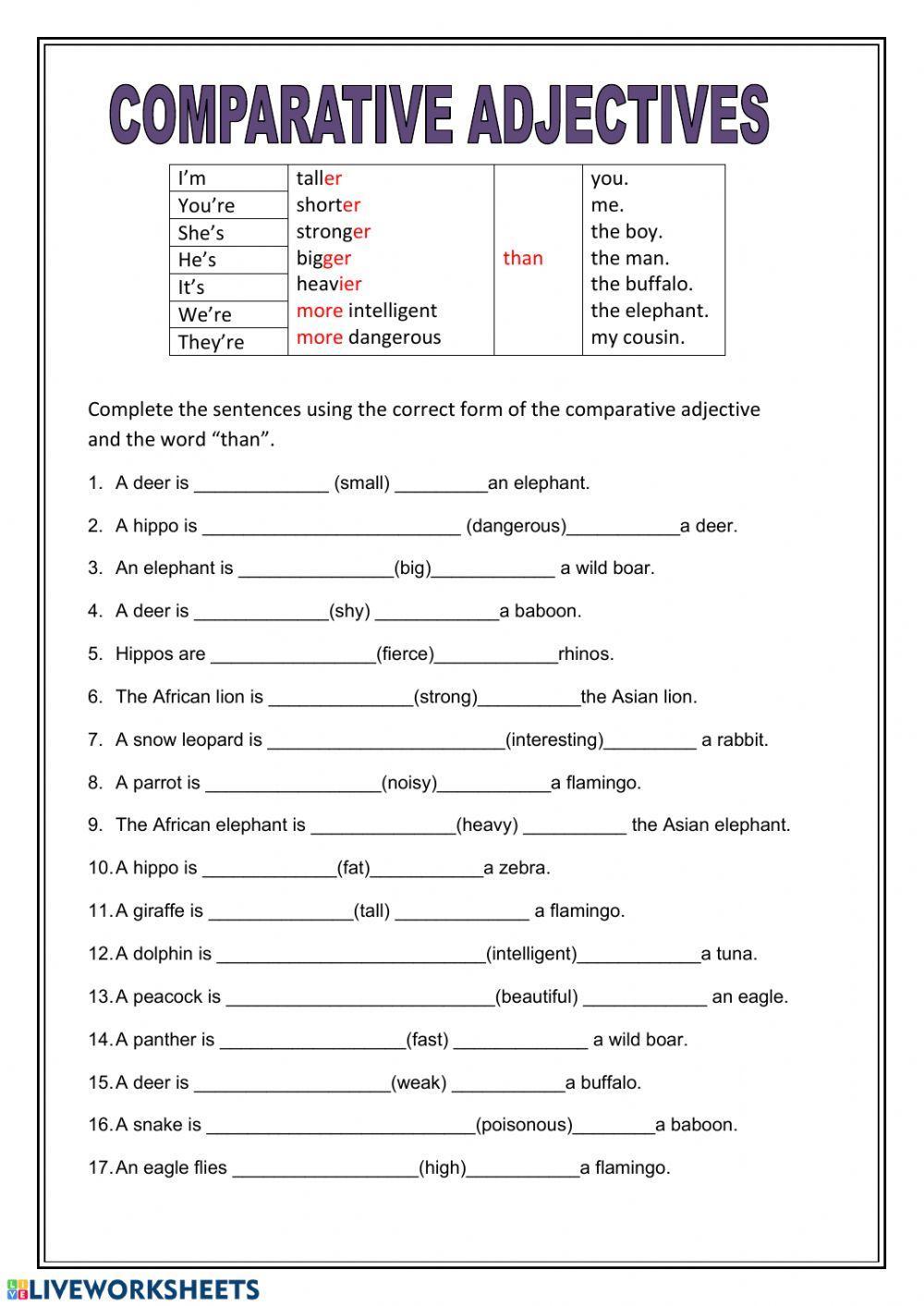

Superlative adjectives are almost always preceded by the definite article "the," as they point to a unique item or person that stands out from the rest. They signify the ultimate, the extreme, the pinnacle of a particular quality.
Formation Rules: Crafting the Superlative
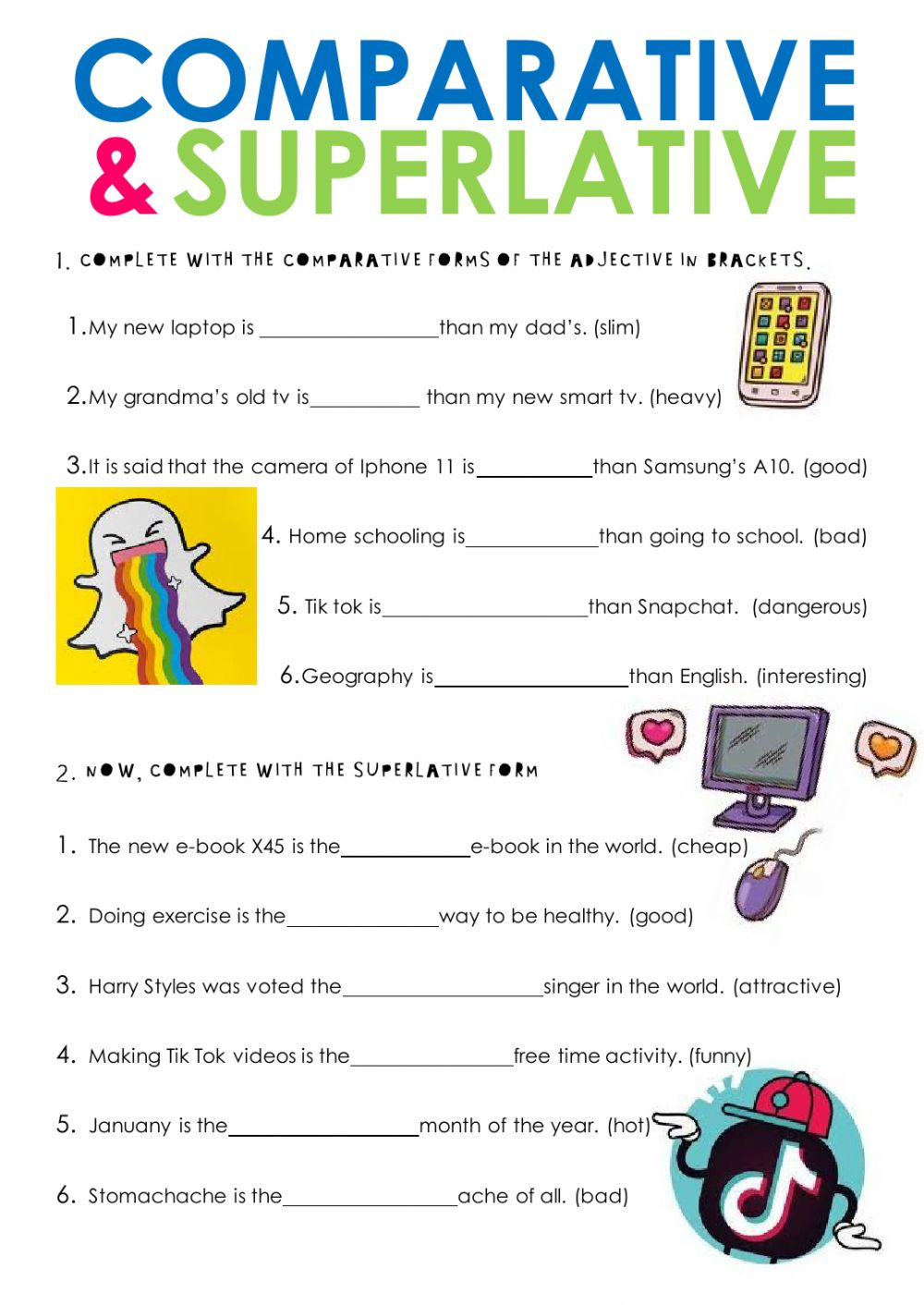
The formation of superlative adjectives follows specific rules, primarily depending on the number of syllables in the adjective:
-
One-Syllable Adjectives:
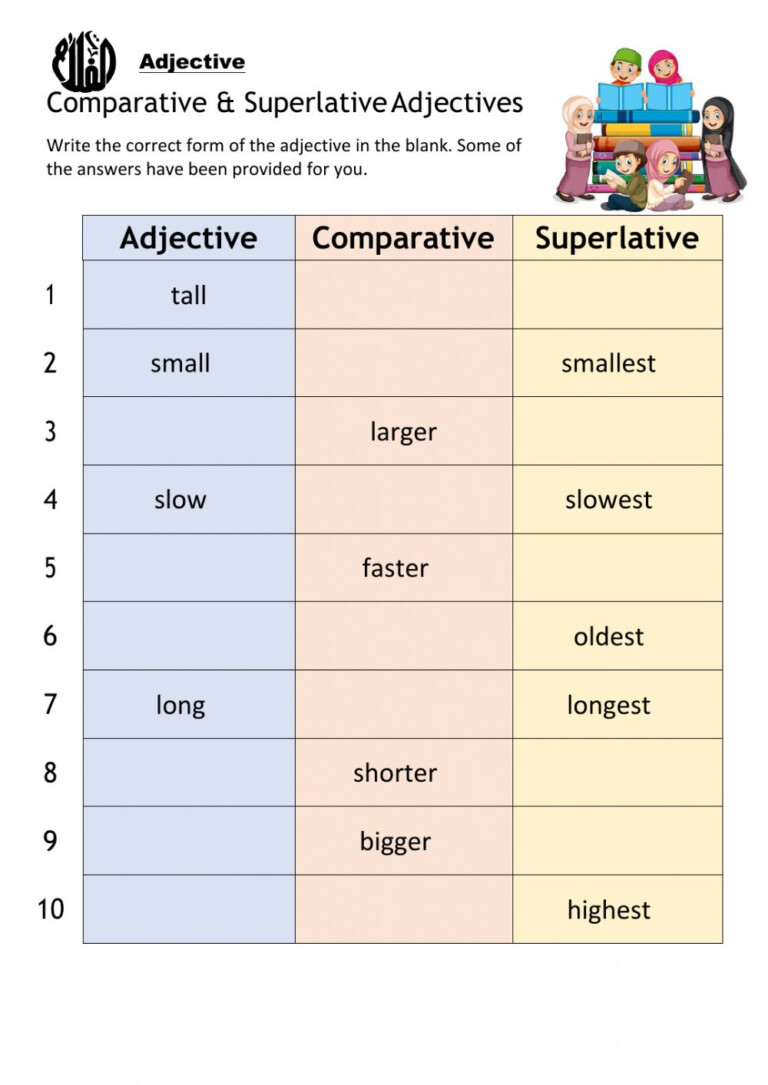
- Add "-est" to the end of the adjective.
- Examples: cold -> coldest, old -> oldest, fast -> fastest.
- If the adjective ends in "e," just add "-st."
- Examples: large -> largest, wide -> widest.
- If the adjective ends in a single vowel followed by a single consonant, double the final consonant before adding "-est."
- Examples: big -> biggest, hot -> hottest, thin -> thinnest.
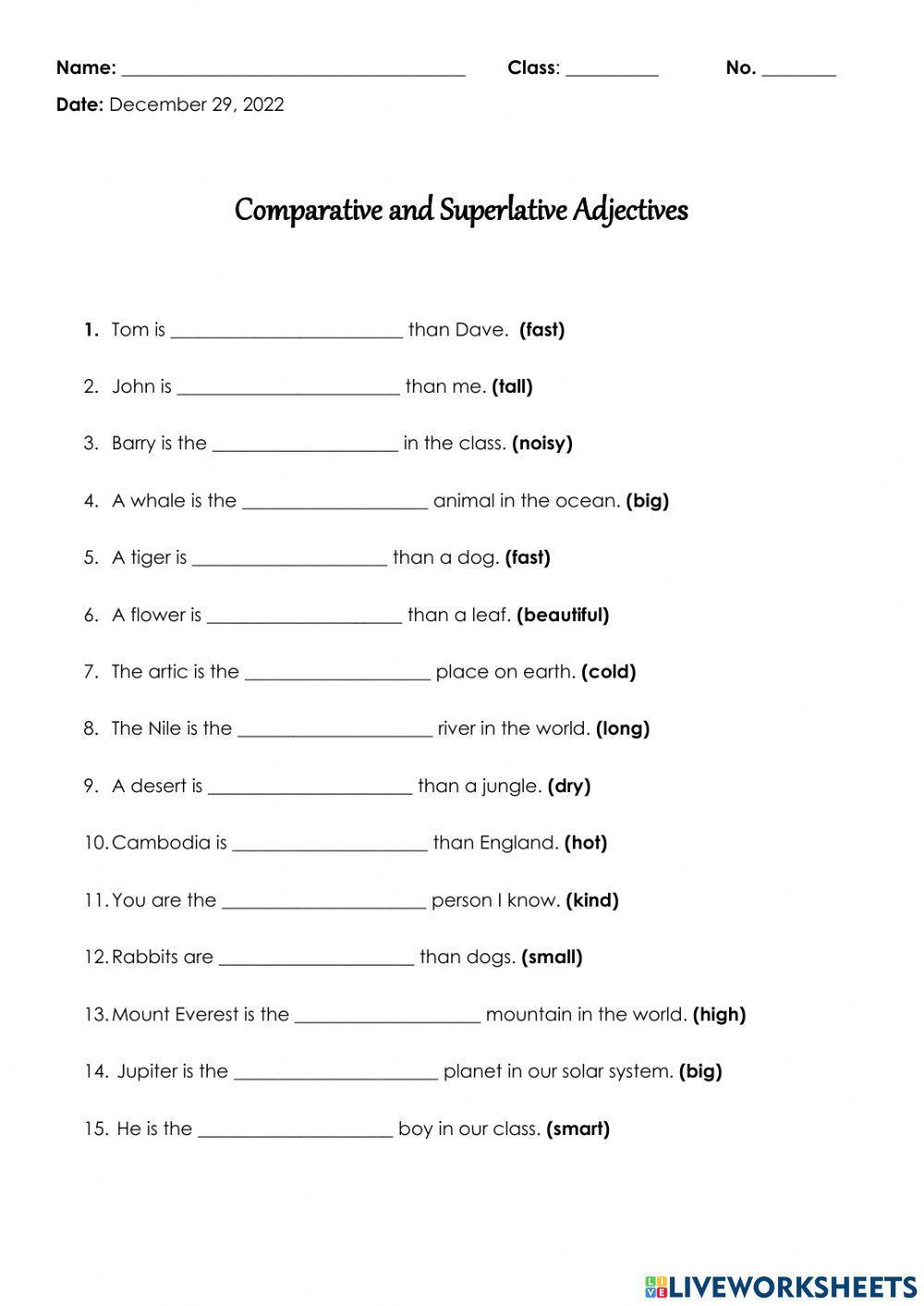
-
Two-Syllable Adjectives:
- If the adjective ends in "y," change the "y" to "i" and add "-est."
- Examples: happy -> happiest, easy -> easiest, noisy -> noisiest.
- For most other two-syllable adjectives, use "most" or "least" before the adjective.
- Examples: famous -> most famous, careful -> most careful. (Note: Some two-syllable adjectives can take either "-est" or "most/least," but it’s often safer to use "most/least" if unsure, especially if they don’t end in ‘y’).
-
Three or More Syllable Adjectives:
- Always use "most" or "least" before the adjective.
- Examples: beautiful -> most beautiful, intelligent -> most intelligent, difficult -> most difficult, interesting -> least interesting.
-
Irregular Superlatives:
- Some adjectives have irregular superlative forms that do not follow the standard rules. These must be memorized.
- Examples: good -> best, bad -> worst, far -> farthest/furthest, little -> least, much/many -> most.
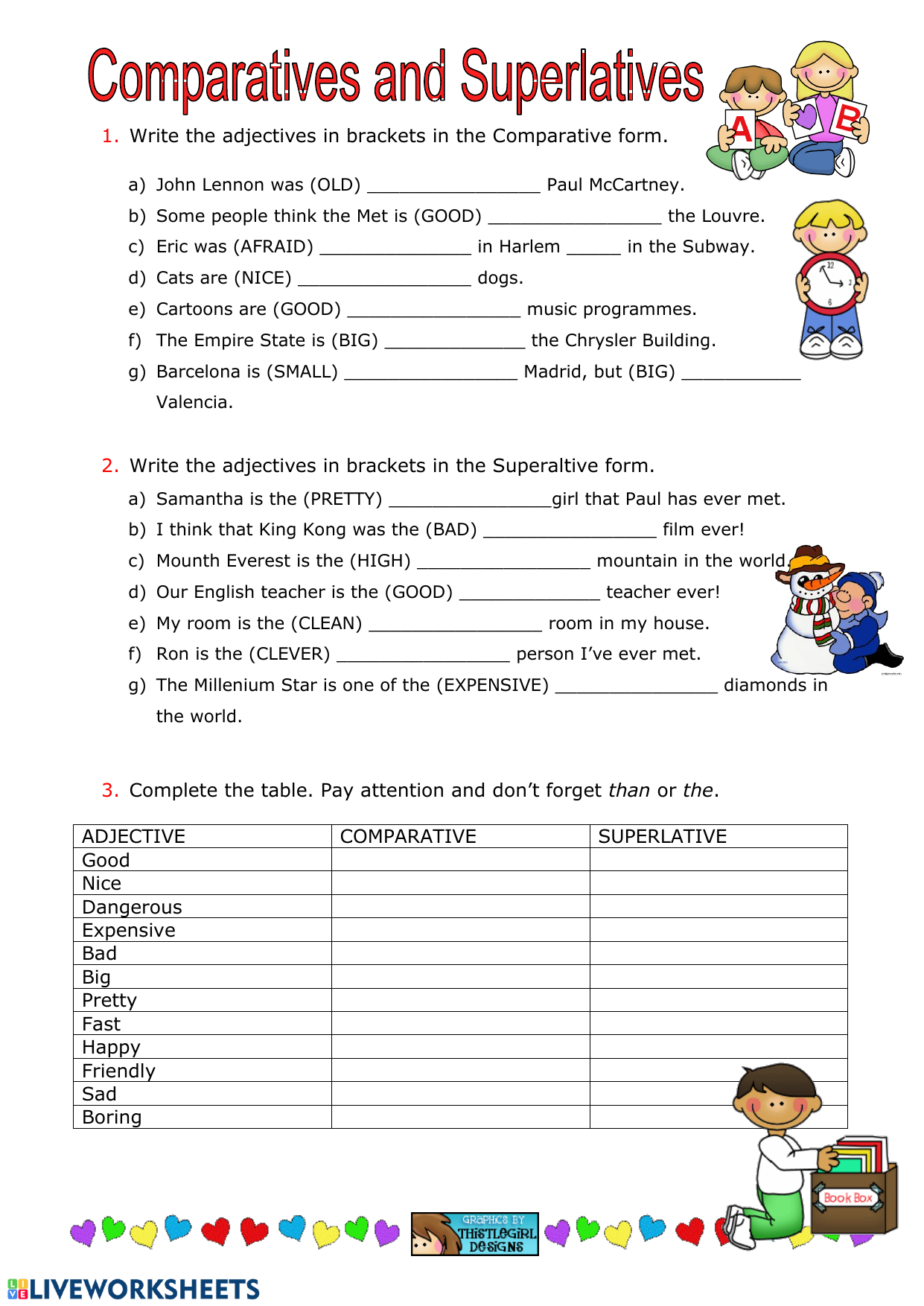
Understanding these rules is the foundational step, but consistent practice is what truly embeds them in a learner’s mind. This is precisely where the utility of a well-designed superlative adjectives worksheet becomes apparent.
Why a Superlative Adjectives Worksheet is Indispensable for Learning
While textbooks and grammar guides provide the rules, a worksheet offers the critical opportunity for active application and reinforcement. Here’s why a dedicated superlative adjectives worksheet is an indispensable part of the learning process:
-
Active Learning and Application: Reading about grammar rules is passive. A worksheet demands active engagement. Learners must recall the rules, apply them to various contexts, and actively construct sentences using superlatives. This hands-on approach deepens understanding far more effectively than rote memorization.
-
Reinforcement and Retention: Repetition is key to mastering new concepts. A worksheet provides numerous opportunities to practice the formation and usage of superlatives, solidifying the rules in memory and making their application feel more natural over time.
-
Identification of Knowledge Gaps: As learners complete exercises, they inevitably encounter situations where they are unsure, make mistakes, or forget a rule. These moments are invaluable. They pinpoint specific areas of confusion or weakness, allowing learners (or their instructors) to focus on those particular aspects for further review.
-
Building Confidence: Successfully completing exercises on a worksheet provides a sense of accomplishment. Each correct answer reinforces the learner’s understanding and builds confidence in their ability to use superlative adjectives accurately, encouraging them to tackle more complex linguistic challenges.
-
Versatility in Learning Environments: A superlative adjectives worksheet is highly versatile. It can be used in a classroom setting for group activities or independent work, as homework to reinforce concepts taught in class, for self-study by independent learners, or even by parents homeschooling their children.
-
Assessment Tool: For educators, worksheets serve as an excellent informal assessment tool. They offer quick insights into students’ comprehension levels and highlight common errors across the class, informing future lesson planning.
Components of an Effective Superlative Adjectives Worksheet
Not all worksheets are created equal. A truly effective superlative adjectives worksheet should feature a diverse array of exercise types to cater to different learning styles and ensure comprehensive understanding. Here are key components:
-
Fill-in-the-Blanks: This classic exercise provides sentences with a blank space where the correct superlative form of a given adjective needs to be inserted.
- Example: Mount Everest is the (high) _____ mountain in the world.
-
Sentence Completion/Transformation: Learners are given a positive or comparative adjective and asked to rewrite a sentence using its superlative form.
- Example: (Good) My dog is a good swimmer. -> My dog is the _____ swimmer in the neighborhood.
-
Multiple Choice: This format is excellent for quick assessment and rule recognition, especially for irregular forms or tricky two-syllable adjectives.
- Example: She is the _____ (a. most kind b. kindest c. more kind) person I know.
-
Error Correction: Students identify and correct grammatical errors related to superlative adjective usage in given sentences. This tests their critical eye and understanding of common mistakes.
- Example: The elephant is the more biggest land animal. (Correction: The elephant is the biggest land animal.)
-
Matching Exercises: Matching adjectives to their correct superlative forms, or matching sentences with appropriate superlative descriptions.
-
Creative Writing Prompts: This takes the learning beyond simple mechanics. Learners are prompted to write short paragraphs or sentences using superlative adjectives to describe people, places, or things.
- Example: Describe your dream vacation spot using at least three superlative adjectives.
-
Real-World Contexts: Worksheets that use relatable or interesting scenarios (e.g., comparing animals, describing famous landmarks, talking about personal preferences) make the exercises more engaging and meaningful.
-
Clear Instructions and Examples: Every section should have concise, easy-to-understand instructions and a clear example to guide the learner.
-
Answer Key: Crucial for self-correction and independent learning. An answer key allows learners to check their work immediately and understand where they went wrong, facilitating faster learning.
-
Gradual Difficulty: A well-structured worksheet often starts with simpler, more direct applications and gradually introduces more complex scenarios, irregular forms, or nuanced comparisons.
Maximizing the Utility of Your Superlative Adjectives Worksheet
To get the most out of a superlative adjectives worksheet, consider these strategies:
- Review Rules First: Before starting the exercises, quickly review the formation rules, especially the irregular forms.
- Work Systematically: Go through the exercises one by one, focusing on accuracy rather than speed.
- Self-Correction with an Answer Key: Use the answer key to check your work. Don’t just mark answers right or wrong; understand why an answer is correct or incorrect. If you made a mistake, go back to the rule that applies.
- Identify Patterns of Error: If you consistently make the same type of mistake (e.g., forgetting to double the consonant, or using "most" with a one-syllable adjective), make a mental note and focus extra attention on that specific rule.
- Integrate with Speaking and Writing: Once you’ve practiced with the worksheet, try to consciously use superlative adjectives in your conversations and written assignments. The more you apply them in real-world contexts, the more natural they will become.
- Don’t Be Afraid to Revisit: Grammar concepts often require periodic review. If you feel rusty, pull out a superlative adjectives worksheet and go through it again, or try a different one.
Beyond the Worksheet: The Broader Benefits of Mastering Superlatives
Mastering superlative adjectives extends far beyond simply getting a good grade on a worksheet. It profoundly impacts a learner’s overall communication skills:
- Enhanced Descriptive Language: Superlatives add power and precision to descriptions, allowing speakers and writers to paint vivid pictures and convey exact meanings. Instead of saying "a very tall building," one can say "the tallest building."
- Improved Clarity and Conciseness: Using the correct superlative avoids awkward circumlocutions (e.g., "the one that is most good" vs. "the best").
- Richer Storytelling: Superlatives are vital for creating engaging narratives, highlighting climaxes, and emphasizing unique characteristics of characters or settings.
- Boosted Critical Thinking: Choosing the most appropriate superlative requires careful consideration of the context and the specific quality being highlighted.
- Greater Confidence in Communication: Knowing how to use these forms correctly empowers learners to express themselves with greater accuracy and less hesitation.
Conclusion
In the journey of language acquisition, every grammatical concept is a building block, and superlative adjectives are certainly among the most visually and expressively potent. They allow us to articulate the extremes, to pinpoint the unique, and to bring unparalleled clarity to our comparisons. While understanding the rules is fundamental, the true path to mastery lies in consistent, active practice. This is precisely why a well-designed, comprehensive superlative adjectives worksheet is not just a helpful resource, but a truly indispensable tool for students, educators, and self-learners alike.
By providing varied exercises, immediate feedback, and opportunities for both reinforcement and self-assessment, a superlative adjectives worksheet empowers learners to confidently navigate the intricacies of comparative language. Ultimately, mastering these powerful adjectives paves the way for more precise, vivid, and impactful communication in both written and spoken English, truly unleashing the power of precision.
